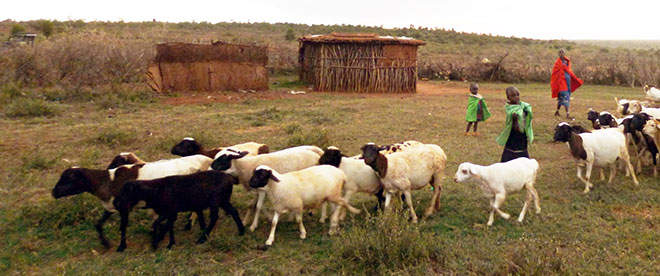LAIKIPIA PLATEAU, KENYA - Camels and giraffes munch on crunchy acacia leaves by a grass-fringed watering hole, oblivious to the stranger admiring them from a distance.
From my balcony in the Ol Malo House, I gaze across a vast, rugged and wilderness-rich sanctuary. The house is built on a craggy cliff on the edge of the Great Rift Valley amid the foothills of Mount Kenya. There are no phones and no TV; the stark, endless wilderness is the only distraction at this famous safari lodge.
After a 45-minute flight from Kenya’s capital, Nairobi, we touch down on the red dirt runway of the local airport. On our approach to the lodge, we pass local Samburu tribespeople tending their livestock on the dusty terrain where they’ve lived and thrived for centuries.
“Ol Malo” is a Samburu expression meaning “the place of the greater kudu” (a large antelope). The 10-room lodge is the vision of Colin and Rocky Francombe, a husband-and-wife team who trace their Kenyan ancestry back three generations. They work closely with their Samburu neighbours to conserve the 5,000-acre nature preserve.
The Francombes built their lovely lodge, often moving rocks and dirt by hand, in the style of a manyatta, or traditional Samburu stone house with thatched roof. The home is elegantly furnished with artifacts from their travels and they take great pride in the themed suites they’ve created.
The spacious two-storey room I’m staying in is named Tandala after an orphaned kudu that lived with the family for 21 years. The quirky, cave-like room reflects the rocky lava landscape that surrounds the lodge. It comes with an elaborately carved olive-wood bed and a canvas couch perfectly positioned to observe the busy watering hole.
The custom-made deep soaker tub in the ensuite bathroom looks big enough to accommodate a kudu or two.
As comfy as the rooms are, visitors are encouraged to “challenge themselves, get outside their comfort zone,” says Andrew, one of the Francombes’ three children, all of whom are actively involved in their parents’ conservation efforts.
Andrew’s wife Chyulu, with her trusty dog Siambo, leads our first game drive. As we pass a herd of white-bellied Grevy’s zebras, Chyulu suddenly cuts the engine, raises her binoculars and scans the horizon.


Above: Wildlife and farm animals share the same rugged terrain in this part of the world.
“Look over there,” she says. “It’s a pair of reticulated giraffes.”
Known for their patchwork of chestnut-coloured spots with bright white outlines, the reticulated giraffes are only found north of the equator in this part of Kenya.
“I absolutely love it here,” says Chyulu, as we drive deeper into the heart of Samburuland.
The sun illuminates the distant peaks and the nearby valleys of the donyo (the hills of Laikipia), creating a burst of colour amid the grasses and acacia trees. A herd of horned beisa oryx dash across the golden slopes. This is Africa as I imagined it.
Chyulu accelerates her jeep up a hill, stones crackling under the tires as the road curls around a bend to reveal the ultimate view.
“We thought of a bush breakfast here,” Chyulu says as we head to a rustic setting replete with a red checkered tablecloth adorned with organic honey, homemade jams, fresh yogurt and bold Kenyan coffee.


Above: The hard work to survive in these harsh conditions produces strong people.
In the afternoon, we retreat to the sanctuary of the lodge, where I admire the majesty of Mount Kenya from the infinity pool.
That evening, I join Andrew for a sunset ride in the lodge’s helicopter. We fly over the spectacular valley to the Uaso Nyiro River, along the way passing granite pinnacles where a crocodile sits atop the rocks soaking up the fading rays.
A couple of baboons play by the river bank and a towering black-headed heron soars like a flying dinosaur casting a shadow below us.
“What lies beyond the ancient walls?” I ask Andrew.
He manoeuvres the helicopter above the canyon walls and flies over bush land where families of elephants roam freely. I count 48 beasts, including a couple of babies.
“Let’s park,” Andrew says, and lands the chopper atop a spiky pinnacle called “Naltodo,” which feels about 40 storeys high.
It feels like we’re sitting on top of the world as we watch the sun set and enjoy the real Africa.
About the Author
Ilona Kauremszky is an award-winning journalist and a syndicated travel columnist. She has penned pieces for leading publishers in North America, the U.K. and Southeast Asia. She also makes appearances on TV and radio. Co-producer of mycompass.ca, Ilona is forever finding great stories in the strangest places.